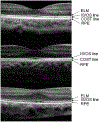Outer Retinal Structural Alternation and Segmentation Errors in Optical Coherence Tomography Imaging in Patients With a History of Retinopathy of Prematurity
- PMID: 27038892
- PMCID: PMC12288117
- DOI: 10.1016/j.ajo.2016.03.030
Outer Retinal Structural Alternation and Segmentation Errors in Optical Coherence Tomography Imaging in Patients With a History of Retinopathy of Prematurity
Abstract
Purpose: To evaluate retinal anatomy and segmentation errors from spectral-domain optical coherence tomography (SD-OCT) imaging in school-aged children.
Design: A prospective cohort study in a referral medical center.
Methods: One hundred thirty-three eyes of 133 patients were enrolled. Patients were grouped as those who were treated for retinopathy of prematurity (ROP) (ROP-Tx group); those with spontaneously regressed ROP (ROP-non-Tx group); other premature patients (premature group); and full-term age-matched children (full-term group). Anatomy and segmentation errors of retina were evaluated by SD-OCT.
Results: The mean age at assessment was 9.5 years (range, 4-16 years). The external limiting membrane (ELM) and the cone outer segment tips (COST) line were least frequently identified in patients of the ROP-Tx group (65.2% and 47.8%, P = .002 and P < .001, respectively). The visual acuity of the patients did not correlate significantly with the absence of COST line (P = .140) but correlated with the absence of ELM (P < .001). The presence of artifacts, including misidentification of the inner retina, misidentification of the outer retina, out-of-register artifacts, off-center scans, and degraded scan images, was observed to range from 0.6% to 50.0% in 4 groups of patients. All types of errors occurred more frequently in the ROP-Tx group than in the full-term group (all P < .05).
Conclusions: Outer retinal abnormalities were commonly observed in the ROP-Tx group. The higher segmentation errors in the ROP-Tx group might be related to fine structural abnormalities in the outer retina. Future studies are needed to investigate the mechanisms for these structural changes.
Copyright © 2016 Elsevier Inc. All rights reserved.
Figures






References
-
- Browning DJ, McOwen MD, Bowen RM Jr, O’Marah TL. Comparison of the clinical diagnosis of diabetic macular edema with diagnosis by optical coherence tomography. Ophthalmology 2004;111(4):712–715. - PubMed
-
- Apushkin MA, Fishman GA, Janowicz MJ. Monitoring cystoid macular edema by optical coherence tomography in patients with retinitis pigmentosa. Ophthalmology 2004;111(10):1899–1904. - PubMed
-
- Chen TC, Cense B, Pierce MC, et al. Spectral domain optical coherence tomography: ultra-high speed, ultra-high resolution ophthalmic imaging. Arch Ophthalmol 2005;123(12):1715–1720. - PubMed
-
- Sadda SR, Wu Z, Walsh AC, et al. Errors in retinal thickness measurements obtained by optical coherence tomography. Ophthalmology 2006;113(2):285–293. - PubMed
Publication types
MeSH terms
Grants and funding
LinkOut - more resources
Full Text Sources
Other Literature Sources

